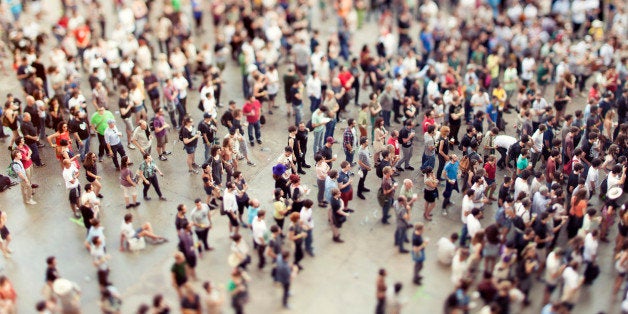
Sometimes, things get out of control.
Take, for example, mass gatherings. Usually they're safe, but every now-and-again, we hear about a disaster where a number of people are crushed to death or injured in a stampede. In retrospect, it seems so avoidable, but is that always the case?
I recently wrapped up a study with some colleagues from Uppsala University's Mathematics Department, and it looks like, at least in some cases, that the risk for injury in mass gatherings naturally emerges from mechanics and the physics of disorder.
Here's what it comes down to: in a crowd packed shoulder-to-shoulder, the random positioning of people relative to their neighbors creates a physical network of contacts. Networks like these have a number of interesting physical properties, but three specifically caught our attention given their ability to drive a disaster:
1) Broken symmetry = massive collective motion.
Circles are very symmetric. Neatly packed oranges at your favorite grocery store also have symmetry, but a little less-so. A dense crowd of people packed together, say at a presidential inauguration, has essentially no symmetry at all. The term of art is called a "broken symmetry," and one of the immediate physical consequences is that a large scale "wave" can propagate through the crowd like sound through air or vibrations on a string. While this massive collective motion has a fancy physics name - a Goldstone mode in case you want to look it up on Wikipedia - the important point is that when the crowd gets moving a fair bit on one side, the folks far away on the opposite side will find out as soon as the wave rolls their way.
2) Soft spots and sudden displacements
Sometimes when you're standing in the middle of a large crowd, you get lucky and find a little island of personal space among the dense sea of humanity. While it's nice to enjoy the room to breathe, these areas in the network of shoulder-to-shoulder contacts can play a special role. You may not realize it at the time, but that little extra personal space you're enjoying is part of something called a "soft spot." Like it or not, but when the crowd starts to rearrange or move en masse, the folks standing in soft spots go through atypically large, sudden, displacements. If you're not careful, these shifts can catch you off guard. Just don't trip and fall...
3) More agitation makes for more waves
Of all our findings, this was the most unexpected. It turns out that if the crowd gets more agitated, the number and direction of physical contacts between individuals will begin to average out. While we interpreted this as a "stochastic resonance," the intellectual abstraction isn't as important as the physical consequence: there's more pathways for more waves to flow. Just like the crowd-sized wave from point (1) above can cause a mass movement, so too can these waves. The trouble is that there's more of them, from more directions, making it even less predictable, and therefore significantly more dangerous.
...
Having laid our main findings out, here's the kicker. To get these potentially dangerous collective motions, all you need is a densely packed crowd and a little "kick" to get things started. Granted, our findings come from physics-based computer simulations, but the basic results are consistent with nearly 20 years of first-hand experience at heavy metal concerts. Sure, these types of crowds have atypically extreme forms of human collective motion (think: mosh pits), but given the political climate, it's better to be aware of the possibilities than go in blind.
Looking for a take-away? Here's a good rule-of-thumb: to minimize risk, be aware of your surroundings. Even assuming the best of humanity, people packed shoulder-to-shoulder don't always have full control of how they move. The random collisions among the network of contacts can add up to some seriously dangerous collective effects. If you find yourself in an area that's noticeably dense, you can always protect yourself and others by moving to an area with more space. Still though, participate in the activities you care about the most, but just be aware of your surroundings.
...
Details, details, details...
"EMERGENT STRUCTURAL MECHANISMS FOR HIGH-DENSITY COLLECTIVE MOTION INSPIRED BY HUMAN CROWDS"
PUBLISHED in Physical Review Letters
AUTHORED BY: Arianna Bottinelli, David T. J. Sumpter, Jesse L. Silverberg
Fun fact: a lot of the inspiration for this work came from the physics of jamming.